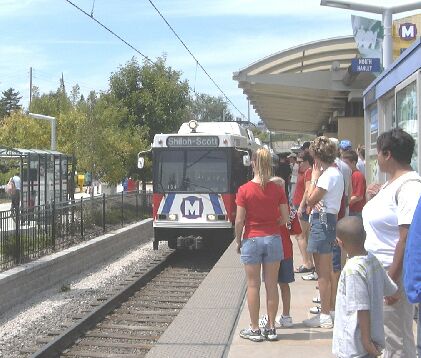
Light Rail Now! can be contacted at: Light Rail Now! |
It's always interesting to follow the dialogue between rail supporters and rail opponents on the internet. It seems that the more progress rail transit makes, and the more public support it gains, the more ferocious the anti-rail barrage becomes. Just about a year ago, in February 2004, urban rail opponent Randall O'Toole released his anti-rail screed titled Great Rail Disasters, wherein he proclaimed that "rail transit has negative net impacts on every urban area in which it is located." O'Toole writes:
O'Toole is recognized as a particularly virulent rail opponent, even though his professional background is in forestry and he does not appear to have any formal training or experience in transportation planning or engineering. His writing generated several responses from rail proponents, including a rebuttal document by Tod Litman from the Victoria Transport Policy institute entitled Rail Transit in America: A Comprehensive Evaluation of Benefits. Here are some excerpts from the abstract:
Litman goes on to critique O'Toole's publication:
A .pdf file of the entire document is available at the following URL: http://www.vtpi.org/railben.pdf I recommend it to anyone who is interested in the urban rail debate. More recently, staff from the Federal Reserve Bank of St. Louis offered an economic analysis of St. Louis's light rail system in their magazine The Regional Economist, in an article titled Light Rail: Boon or Boondoggle? available at the following URL: http://www.stlouisfed.org/publications/re/2004/c/pages/light_rail.html In this article, economic researchers Molly D. Castelazo and Thomas A. Garrett write:
This underscores some of the fundamental differences in perception between rail proponents and rail opponents. In this case, the article focuses mainly on costs, largely ignoring societal benefits. Castelazo and Garrett suggest that light rail is inefficient because its cost of providing service is supposedly far higher than people are willing to pay (i.e., it requires subsidies to operate). They suggest that toll roads would be a more efficient means of reducing overall congestion and expanded bus service or express buses would be more efficient ways of providing public transportation to low income citizens, even though they assert that all public transportation is less cost-efficient than the private automobile. The article even contains another variation of the tired and flawed "for the money spent on rail, you can buy a car for every transit rider" argument (although this time, instead of a Mercedes or Lexus, the car of choice is a Toyota Prius).
The Castelazo and Garrett article elicited a response from Michael Setty at publictransit.us, in which he states:
Setty's complete analysis can be viewed at the following URL: I personally am of the opinion that economists who focus completely on the monetary "efficiency" of light rail and use that as the sole means to evaluate its utility are missing the overall picture because there is so much more to the debate. However, not everyone in the field of economics believes rail transit is inefficient. Dr. Haynes Godddard, for example, a professor of economics at the University of Cincinnati, argues in favor of rail transit and takes issue with its critics. His analysis can be viewed at the following URL: http://www.cmt-stl.org/images/Goddard%20Comments%20Castelazo%20Garrett.pdf And finally, there is the ongoing resistance to rail transit from within the federal government itself. The Sierra Club has recently released a report entitled Missing the Train: How the Bush Administration's Transportation Proposal Threatens Jobs, Commutes, and Public Transit Ridership. It's another good read, even though I'll readily admit that the Sierra Club is not an unbiased entity in this debate. For example, it suggests that Cincinnati's proposed light rail system is one of the projects threatened by the Bush Administration's proposal to reduce the federal funding share for mass transit in the transportation authorization bill currently being debated in Washington. In actuality, the Cincinnati project was doomed by the negative outcome of a 2002 referendum, not by anything the White House has done. Even though opponents continue to "rail" against them, urban rail systems are being opened and expanded at a rapid pace. In addition to the January 1, 2004 opening of the 7.5-mile light rail line in Houston, recent extensions to streetcar systems began operation in Memphis and New Orleans. The Hiawatha light rail line recently began service in Minneapolis and the new monorail in Las Vegas was finally put into service on July 15th, 2004. The refurbished Overbrook line in Pittsburgh is up and running this past summer (2004), and the Yellow Line (interstate MAX) in Portland began service May 1st, 2004. Extensions to the light rail networks in San Jose and Sacramento have recently opened as well. St. Louis is busy building the so-called "Cross-County Extension" to their light rail line, and installation of new light rail systems in Phoenix and Seattle in under way. And this is by no means a complete list – but you can find a good listing of all US urban rail transit lines opened or expanded since 1980 at the following URL: http://www.carquinezassociates.com/ptlibrary/usnewurbanrail.htm For all the ranting and raving that the anti-rail faction is doing, it's obvious that few cities are listening to them. Thomas B. Gray is an urban planner in Houston, Texas and webmaster of his own website at the following URL: This commentary has been adapted from one of his essays. Thomas Gray can be reached at tbgray@mindspring.com Light Rail Now! website Updated 2005/02/01 |
|
|
|